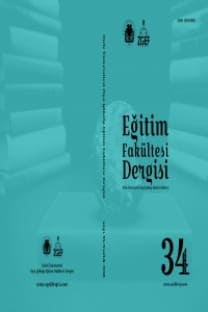SERUMDAKİ PROTEİN HİDRASYONUNUN NMR T1 ÖLÇÜMLERİ İLE İNCELENMESİ
Albümin, T1 spin-örgü durulma zamanı, ilgi zamanı
The Investigation of Protein Hydration in Serum by T1 Relaxation Measurement
Albumin, T1 relaxation times, correlation times,
___
- Balasubramanian, S., Bandyopadhyay, S. Pal, S. & Bagchi, B. (2003). Dynamics of water at the interface of a small protein, enterotoxin, Current Science, 85(11), 1571-1578.
- Bertini, I., Fragai, M., Luchinat, C. & Parigi, G. (2000). 1H NMRD profiles of diamagnetic proteins: a model-free analysis. Magn. Reson. Chem, 38, 543-550.
- Bertini, I., Luchinat, C., Nerinovski, K., Parigi, G., Cross, M., Xiao, Z. & Wedd, A. G. (2003). Application of NMRD to hydration of rubredoxin and a variant containing a (Cys- S)3Feııı(OH) site, Biophys. J. 84, 545-551.
- Bloembergen, N., Purcell, E. M. & Pound, R. F. (1948). Relaxation Effects in Nuclear Magnetic Resonance Absorption Phys.Rev, 73, 679-712.
- Brooks, R. A. Battocletti, J. H. Sances, JR Larson, S. J. Bowman, L.R. & Kudravcev,V. (1975). Nuclear magnetic relaxation in blood. IEEE Transac.Biomed, Engin.BME-22(1), 12- 16.
- Cameron, I. L, Ord, V. A & Fullerton, G. D. (1988). Water of hydration in the intra and extra cellular environment of human erythrocytes. Biochem.Cell.Biol, 66, 1186-1199.
- Daskiewicz, O. K., Hennel, J. W. & Lubas, B. (1963). Proton magnetic relaxation and protein hydration, Nature, 200, 1006-1007.
- Fullerton, G.D., Ord, V. A. & Cameron,I.L. (1986). An evaluation of the hydration of lysozyme by a NMR titration method. Biochim.Biophys.Acta, 869, 230-246.
- Fullerton, G. D. (1988). Physiologic Basic of Magnetic Relaxation in Magnetic Resonance Imaging, David D. Stark & W. G. Bradley (Ed.)(ss. 36). St. Louis: The C.V. Mosby Company.
- Gallier, J., Rivet, P. & Certaınes, J.de. (1987). 1H- and 2H-NMR study of bovine serum albumin solutions. Biochimica et Biophysica Acta, 915, 1-18.
- Grösch, L. & Noack, F. (1976). NMR relaxation investigation of water mobility in aquueous bovine serum albumin solutions. Biochimica et Biophysica Acta, 453, 218-232.
- Halle, B. (2004). Protein hydration dynamics in solution: a critical survey, Phil. Trans. R. Soc. Lond. B. 359, 1207-1224.
- Hennel, J. W. & Klinowsky, J. (1996). Çekirdek Magnetik Rezonansın Temelleri. (Çev: S. Bahçeli). Ankara:Bizim Büro Basımevi (Özgün kitap 1993’da yayımlandı).
- Kavak, G. (2000). “Serum Proteinlerinin Spin-Örgü Durulma Mekanizmalarının NMR ile incelenmesi”. Yayımlanmış doktora tezi, Dicle Üniversitesi Fen Bilimleri Enstitüsü, Diyarbakır.
- Koenig, S. H. & Schillinger, W. E. (1969). Nuclear magnetic relaxation dispersion in protein solutions, J. Biol. Chem. 244(23), 6520-6526.
- Koivula, A., Suominen, K., Timonen,T. & Kiviniitty, K. (1982). The spin-lattice relaxation time in the blood of healthy subjects and patients with malignant blood disease. Phys.Med.Biol., 27(7), 937-947.
- Marshall, A. G., Schmidt, P. G. & Sykes, B.D. (1972). Effect of Internal Rotation on Nuclear Magnetic Relaxation Times for Macromolecules. Biochemistry, 11(21), 3875-3879.
- Pouliquen,D. & Gallois, Y. (2001). Physicochemical properties of structured water in human albumin and gammaglobulin solutions. Biochimie, 83, 891-898.
- Raeymaekers, H. H., Borghys, D. & Eisendrath, H. (1988). Determinants of water proton T1 in blood serum. Magn.Reson.Med., 6(2), 212-216.
- Tarek, M. & Tobias D. J. (2000). The dynamics of protein hydration water: A quantitative comparison of molecular dynamics simulations and neutron-scattering experiments. Biophysical Journal, 79, 3244-3257.
- Yılmaz,A., Ulak F. Ş. & Batun, M. S. 2004. Proton T1 and T2 relaxivities of serum proteins, Magnetic Resonance İmaging, 22(7), 683-688.
- Yılmaz, A. Chu, S. C. & Osmanoğlu, S. (1988). Dependence of the solvent proton 1 Ton the 1 iron content in normal human serum. Magn.Reson.Med., 7(6), 337-339.
- Yılmaz, A., Otludil, B., Batun, M. S., Ensari,Y., Longo, R. & Palma, L.D. (1992). Determination of ion and iron binding capacity by NMR. Phys.Med.Biol., 37, 1589- 1596.
- Yılmaz, A., Budak, H. & Longo, R. (1998). Paramagnetic contribution of serum iron to the spin- lattice relaxation rate(1 T) determined by MRI. Applied Magnetic Resonance, 1 14(1), 51-58.
- Zimmerman, J. R, & Brittin, W. E. (1957). Nuclear magnetic resonance studies in multiple phase systems: lifetime of a water molecule in an adsorbing phase on silica gel. J.Phys. Chem, 61, 1328-1333.
- ISSN: 1305-0060
- Yayın Aralığı: Yılda 2 Sayı
- Başlangıç: 1995
- Yayıncı: Dicle Üniversitesi
ATATÜRK ÜNİVERSİTESİ AĞRI EĞİTİM FAKÜLTESİ ÖĞRENCİLERİNİN OKUL DENEYİMİ DERSİNİ
KÜRESELLEŞME KARŞISINDA TÜRK EĞİTİM SİSTEMİ
Sema Agüloğlu FİNCAN, Veysi OKUMUŞ
2006 ÖĞRENCİ SEÇME SINAVI (ÖSS) KİMYA SORULARININ KAPSAM ve DÜZEY YÖNÜNDEN DEĞERLENDİRİLMESİ
Hüseyin Hakan İNCE, Sait YÜCEL, Rıfat EFE
TEVFİK FİKRET’İN ŞİİRLERİNDE ÇOCUK ve GENÇLİK
İLKÖĞRETİM 4. SINIF FEN ve TEKNOLOJİ DERS KİTABININ DEĞERLENDİRME ÖLÇÜTLERİ YÖNÜNDEN İNCELENMESİ
Abdulkadir MASKAN, M. Handan MASKAN, Kasım ATABAY
GÜNEYDOĞU ANADOLU BÖLGESİ ve YAKIN YÖRESİNİN DEPREMSELLİĞİ
M. Şefik İMAMOĞLU, Erhan ÇETİN
